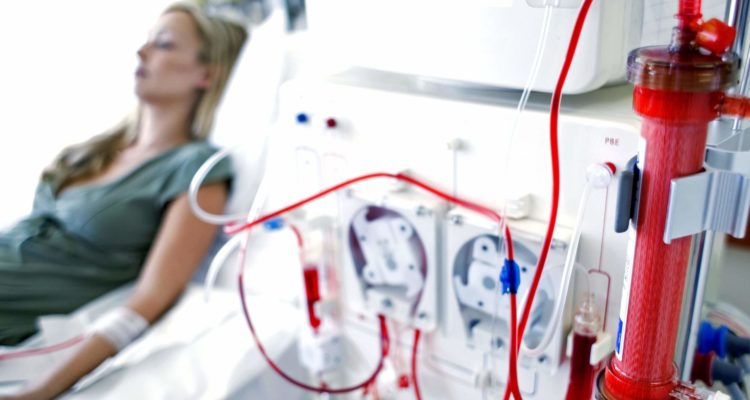
What is dialysis and who needs it
0
It will help if the kidneys do not cope with their work .
What is dialysis
Dialysis is a method of cleaning the blood from harmful substances and excess fluid using a special hypertonic solution. It contains electrolytes, as in blood plasma, as well as a high concentration of glucose. During the procedure, such a solution is placed on one side of the semipermeable membrane, and blood is placed on the other. As a result, glucose extracts water from the blood with uric acid, small proteins and other toxic substances dissolved in it.
In a healthy person, the kidneys are responsible for filtering blood and producing urine. This happens in the vascular plexuses (glomeruli). But when they are damaged, metabolic products, electrolytes and other compounds accumulate in the body. If all of this is not removed by dialysis, the person may die.
Who gets dialysis
Most often, the procedure is prescribed for chronic kidney failure, which can develop for various reasons. Here they are:
- diabetes;
- arterial hypertension;
- glomerulonephritis, or immune inflammation of the kidneys;
- vasculitis-inflammation vessels;
- polycystic kidney disease – the formation of a large number of cavities with fluid in them.
Sometimes dialysis is required in acute renal failure. This condition develops quickly, within two days. It can be associated with drug or drug poisoning, shock due to a burn, blood loss, or sepsis, as well as blockage of the urinary tract with a stone or blood vessels in the kidneys with blood clots.
The main criterion that a doctor focuses on when prescribing dialysis — decrease in kidney function up to 10-15%. To determine this, an analysis of the glomerular filtration rate is performed. The study shows how small kidney vessels pass various substances through them.
What dialysis can be
The procedure is carried out in two main ways:
- Hemodialysis. To clean the blood, a special device with a thin membrane is connected to the vessels on a person's arm.
- Peritoneal dialysis. In this case, the patient's own peritoneum is used as a filter. It has many small vessels, so a hypertonic fluid poured into the abdomen will extract water and toxic substances from the blood.
What are the risks of dialysis
Any method of blood purification can cause a feeling of fatigue and increased fatigue. Perhaps, to a greater extent, this is related to the kidney disease itself.
In addition, each dialysis method has specific complications. With hemodialysis, it is:
- Low blood pressure. This happens due to a sharp decrease in the level of fluid in the blood vessels during the procedure.
- Blood infection, or sepsis. It develops when bacteria enter the blood.
- Muscle cramps. This complication also appears due to fluid loss.
- Itchy skin. It increases between dialysis procedures.
- More rare side effects. These are insomnia, joint pain, decreased libido, dry mouth and anxiety.
Peritoneal dialysis has fewer complications. It can cause peritonitis — an infectious inflammation of the abdominal cavity. Also, people who are prescribed such a procedure have an increased risk of developing an abdominal hernia.
How dialysis is performed
The method depends on which method of blood purification the doctor recommended.
Hemodialysis
At first, you need to prepare for the procedure, and it can take several weeks or months. For this, the surgeon will perform an operation on the vessels to which the device will be connected. There are three options for intervention:
- Creation of an arteriovenous fistula. This is the safest way. An artery and a vein are connected on the hand that a person uses less often.
- Arteriovenous graft installation. If the vessels are too small to make a fistula, they are connected using a flexible synthetic tube.
- Insertion of a central venous catheter. This method is used in emergency cases, when there is no time for planned preparation. For this, a temporary tube is inserted into a large vein under the collarbone or in the groin.
When the postoperative wound heals, proceed to the procedure. Hemodialysis can be performed at home, using a portable machine, or in a hospital. Some people have blood purification done two to three times a week for 5-6 hours. Sometimes dialysis is performed every day, but for 2-3 hours.
Before starting the procedure, a person is weighed, his blood pressure, pulse and temperature are measured, and he is seated in a chair. The skin around the access point is cleaned with an antiseptic. Two needles are inserted into the vessels. The first is in the artery from which blood is sucked into the device. There is filtering. Then through the second needle – in the vein – purified blood is returned to the body. During hemodialysis, fluctuating fluid levels in the body may cause discomfort, pressure surges, nausea, and abdominal cramps.
After the procedure, the needles are removed, the skin is covered with a sterile patch, and the person is weighed again.
>
Peritoneal dialysis
You also need to prepare for it. To do this, an incision is made on the skin near the navel, into which a thin tube – a catheter – is inserted. After the operation, it should take 10-14 days for the wound to heal. The tube remains in place as long as dialysis is needed. Through it, a hypertonic solution will be injected into the abdominal cavity.
Further actions depend on the cleaning method. There are two of them:
- Continuous ambulatory peritoneal dialysis. In this case, the person's stomach is filled with a solution. Then she can go about her business, as there is no need to connect to any device. After 4-6 hours, this liquid is drained. You will have to do this three or four times a day.
- Peritoneal dialysis with a continuous cycle. At night, the patient is connected to a special device that pours dialysis water into the stomach and removes it. Three to five such cycles pass during sleep.
How long should you do dialysis
This procedure does not treat the kidneys, it only helps the body purify the blood. Therefore, the duration of dialysis depends on the reason for which it was prescribed. If the health has temporarily deteriorated, for example, due to poisoning or burns, then after the recovery of the body, cleansing will no longer be needed. And with chronic renal failure, dialysis can be stopped only when a kidney transplant is performed.









Leave a Reply